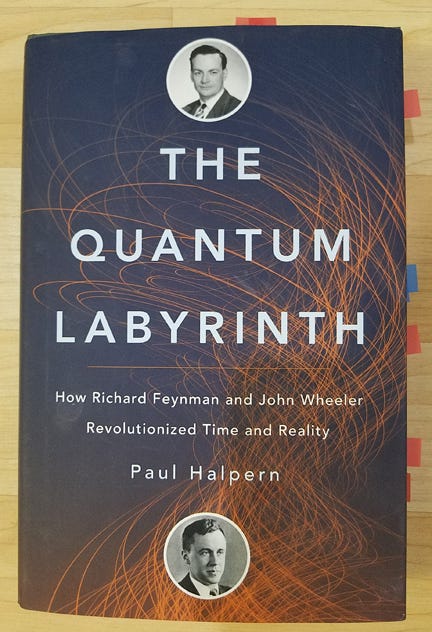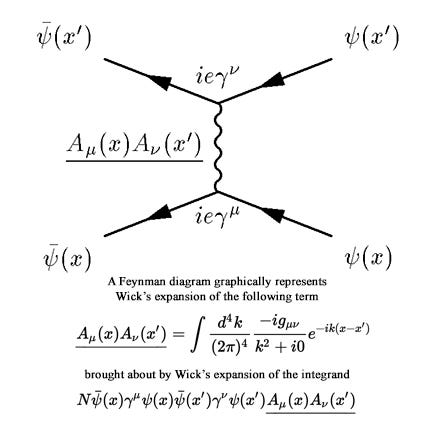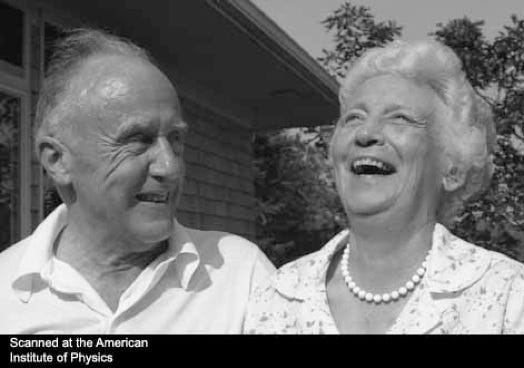The rich, biographical stories of Feynman and Wheeler in Halpern’s “The Quantum Labyrinth”
 |
| John G. Cramer. Department of Physics. University of Washington.: http://www-users.york.ac.uk/~mijp1/transaction/TI_30.html#3.2 |
The first Halpern book I read was in 1994 during my undergrad years studying physics and chemistry. Finding a deeper love for science, I consumed stacks of books during my first free summer when I came across Halpern’s book Time Journeys. For the first time in all of my studies, I understood the whole of science. It felt like all the puzzle pieces in my brain finally clicked. My head was in the clouds, immersed with a deeper understanding of how science, history, and philosophy all intertwined.
Years later, I read Halpern’s Einstein’s Dice and Schrodinger’s Cat, a story about the camaraderie and competition between Einstein and Schrodinger, their histories and their combined and individual quests to find Unified Field Theory. Once again, swept up in the story of two great physicists, the puzzle pieces fit together perfectly, as Halpern’s logical explanations in physics were comprehensible.
This year, I read The Quantum Labyrinth. Once more, Halpern did not disappoint, as the puzzle pieces came together.
The Quantum Labyrinth is an outstanding story about the pairing of Princeton’s Professor John Wheeler and Richard Feynman, who was initially supposed to be Professor Eugene Wigner’s assistant. However, the story is not just about two brilliant physicists; it is an intertwining of their biographies that includes the backstories of their thought processes, the foundations of their philosophies, and the catalysts to their future developments. Halpern eloquently imparts the complexity of physics in such simple and understandable terms while introducing us to these two profound physicists.
The depth of research that Halpern put into The Quantum Labyrinth provides paragraphs of fantastic information for physics hobbyists, well-read scientists, erudite historians, and curious mathematicians. The book takes the reader through the history of physics and into the lives of each person who, in some way, contributed to Feynman’s and Wheeler’s discoveries. As a result, Halpern gives a respectful nod to the extensive works of many scientists some of whom include Albert Einstein, John von Neumann, Robert Oppenheimer, Niels Bohr, Paul Dirac, Kip Thorne, Charles Misner, and Freeman Dyson.
With these historical gestures, for the layperson, Halpern perfectly clarifies many concepts in physics that one might not otherwise understand. For the hobbyist, Halpern makes topics like Einsteinian dynamics, quantum electrodynamics, positronium atoms, and even the Wheeler-Feynman absorber theory easy to understand. Further, Halpern not only simplifies these difficult concepts, but uses these descriptive lessons as effective transitions while he tells the unique stories of Feynman and Wheeler. In addition to their brilliant theories, Halpern includes their insightful observations, some of which involve flying plates, extremes in theories, and their mutual disdain for pseudoscience.
Though the depth of research, historical recounts, and clarity in physics is more than enough to make this a fantastic book, The Quantum Labyrinththoughtfully embraces the relationship between Wheeler and Feynman and impeccably grasps their unique characters. Without any elaboration necessary, Halpern enlightens their greatest qualities that defined who they were to the core. By doing so, Halpern cultivates reader compassion while carefully walking around Feynman’s womanizing qualities and Wheeler’s duty as a scientist in weapons development.
Thus, in reverence for the work that these two brilliant scientists created, Halpern emphasizes their greatest intellectual accomplishments while highlighting their struggles with personal loss and moral ruminations. Halpern writes about Feynman’s emotional valleys and peaks as with the loss of his first wife and his comeback to mental acuity, and he guides us into Wheeler’s world where we come to understand his war duties and comprehend the extent of his hypothetical constructions.
I cannot recommend this book enough. Halpern writes with a style and elocution that expressively connects the discovery of science and depth of history to the profoundly human characteristics of Wheeler and Feynman, all to conclude with a very poignant, philosophical view on the whole of physics. The puzzle pieces click together, once again, to construct a landscape of science, history, philosophy, and humanity. To conclude, The Quantum Labyrinth is not only an exemplary contribution to scientific biographical literature, but it is also a perfect dedication to two of the most valuable scientists of the 20th century.






Comments
Post a Comment